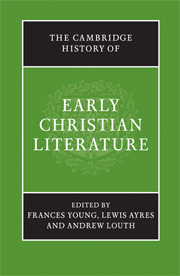Book contents
- Frontmatter
- PART ONE The Beginnings: The New Testament to Irenaeus
- PART TWO THE THIRD CENTURY
- PART THREE FOUNDATION OF A NEW CULTURE: FROM DIOCLETIAN TO CYRIL
- A LITERARY GUIDE
- 21 Classical genres in Christian guise; Christian genres in classical guise
- 22 Arnobius and Lactantius
- 23 Eusebius and the birth of church history
- 24 The fourth-century Alexandrians: Athanasius and Didymus
- 25 Palestine: Cyril of Jerusalem and Epiphanius
- 26 The Cappadocians
- 27 Fourth-century Latin writers: Hilary, Victorinus, Ambrosiaster, Ambrose
- 28 Jerome and Rufinus
- 29 Augustine
- 30 John Chrysostom and the Antiochene School to Theodoret of Cyrrhus
- 31 Cyril of Alexandria
- 32 Hagiography
- 33 Ephrem and the Syriac Tradition
- 34 The literature of the monastic movement
- 35 Women and words: texts by and about women
- 36 Conciliar records and canons
- B CONTEXT AND INTERPRETATION
- Bibliographies
- Index
- Map: The Roman Empire in the late fourth century AD"
- References
31 - Cyril of Alexandria
from A - LITERARY GUIDE
Published online by Cambridge University Press: 28 March 2008
- Frontmatter
- PART ONE The Beginnings: The New Testament to Irenaeus
- PART TWO THE THIRD CENTURY
- PART THREE FOUNDATION OF A NEW CULTURE: FROM DIOCLETIAN TO CYRIL
- A LITERARY GUIDE
- 21 Classical genres in Christian guise; Christian genres in classical guise
- 22 Arnobius and Lactantius
- 23 Eusebius and the birth of church history
- 24 The fourth-century Alexandrians: Athanasius and Didymus
- 25 Palestine: Cyril of Jerusalem and Epiphanius
- 26 The Cappadocians
- 27 Fourth-century Latin writers: Hilary, Victorinus, Ambrosiaster, Ambrose
- 28 Jerome and Rufinus
- 29 Augustine
- 30 John Chrysostom and the Antiochene School to Theodoret of Cyrrhus
- 31 Cyril of Alexandria
- 32 Hagiography
- 33 Ephrem and the Syriac Tradition
- 34 The literature of the monastic movement
- 35 Women and words: texts by and about women
- 36 Conciliar records and canons
- B CONTEXT AND INTERPRETATION
- Bibliographies
- Index
- Map: The Roman Empire in the late fourth century AD"
- References
Summary
The patristic understanding of the Incarnation owes more to Cyril of Alexandria than to any other individual theologian. The classic picture of Christ the God-man, as it is delineated in the formulae of the Church from the Council of Chalcedon onwards, and as it has been presented to the heart in liturgies and hymns, is the picture Cyril persuaded Christians was the true, the only credible, Christ.
Despite this, Cyril has suffered such neglect in modern times that, apart from his conciliar letters, he is unrepresented in the standard late-Victorian English translation of the Fathers, the Library of Nicene and Post-Nicene Fathers. Part of the reason for this is doubtless his depiction in Charles Kingsley’s famous novel, Hypatia (1853), as a sinister figure, cruel and unscrupulous. All this, however, provides a poor basis for understanding one whom Christians from at least the seventh century onwards regarded as the ‘Seal of the Fathers’.
Cyril was born around 375–80 in Alexandria, where he probably received his education, and he may have spent some time as a monk, though this is disputed. He first appears on the scene of history accompanying his uncle Theophilus at the Synod of the Oak in 403. In 412 he was elected bishop to succeed his uncle: he was not the preferred choice of the civil authorities and the early years of his episcopate were uneasy.
- Type
- Chapter
- Information
- The Cambridge History of Early Christian Literature , pp. 353 - 357Publisher: Cambridge University PressPrint publication year: 2004

